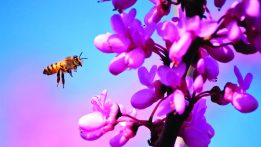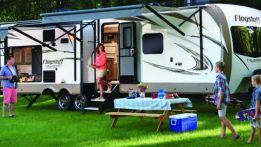 If you’re looking to improve your yard, there’s no better place to start than with your sod. It’s true that flowers, trees, shrubs, paths, and fences can all help make your lawn look prettier, but if you really want to renovate your yard, you need to renovate your lawn. Laying out a high-quality grass can make a world of difference in the look, feel, and health of your yard, and finding the right sod for your home is easier than you might think. North Florida has a wide range of grasses from Bahia to zoysia, and every species comes with its own look, abilities, and needs. To help find the right grass for you, here are some of the most popular grass species in North Florida and their characteristics.
If you’re looking to improve your yard, there’s no better place to start than with your sod. It’s true that flowers, trees, shrubs, paths, and fences can all help make your lawn look prettier, but if you really want to renovate your yard, you need to renovate your lawn. Laying out a high-quality grass can make a world of difference in the look, feel, and health of your yard, and finding the right sod for your home is easier than you might think. North Florida has a wide range of grasses from Bahia to zoysia, and every species comes with its own look, abilities, and needs. To help find the right grass for you, here are some of the most popular grass species in North Florida and their characteristics.
BAHIA GRASS
 Bahia grass is an excellent choice for drier areas, as it is drought-tolerant and flourishes even in sandy soils. This family of grass—which is typically seeded—needs consistent sunlight to grow properly and responds poorly to salt water, but its tough, low-maintenance blades stand up to insects, disease, and even heavy foot traffic.
Bahia grass is an excellent choice for drier areas, as it is drought-tolerant and flourishes even in sandy soils. This family of grass—which is typically seeded—needs consistent sunlight to grow properly and responds poorly to salt water, but its tough, low-maintenance blades stand up to insects, disease, and even heavy foot traffic.
BERMUDA
 Bermuda grass is another great option for Florida landscapes, as it is drought and salt-tolerant and does well in both full sun and partial shade. This grass typically develops into a gray-green color with short rough-edged blades, which grow fast and spread faster. Bermuda grass is known to spread aggressively wherever it can, including flower beds and garden paths, so it’s actually preferable that it be grown in areas with partial shade, as this can limit the grass’s ability to spread. It is great for families, as it’s highly resistant to foot traffic and requires little maintenance.
Bermuda grass is another great option for Florida landscapes, as it is drought and salt-tolerant and does well in both full sun and partial shade. This grass typically develops into a gray-green color with short rough-edged blades, which grow fast and spread faster. Bermuda grass is known to spread aggressively wherever it can, including flower beds and garden paths, so it’s actually preferable that it be grown in areas with partial shade, as this can limit the grass’s ability to spread. It is great for families, as it’s highly resistant to foot traffic and requires little maintenance.
CENTIPEDE
 Centipede grass is perhaps the most common grass type in the Florida Panhandle. Considering its knack for growing in even the most infertile soils, it’s no surprise why. While it isn’t quite as resistant to low temperatures or drought as zoysia nor as salt-resistant as St. Augustine or Bermuda, centipede is perfectly suited for Florida’s warm, wet climate. It also makes for a great turfgrass, which can be sodded, seeded, or plugged. Its rough, light, low-growing blades sprout from long horizontal stolons which spread out along the ground with little-to-no maintenance. As long as it receives some sunlight and doesn’t encounter too much foot traffic, this grass will stay healthy nearly year-round in North Florida, occasionally yellowing in late winter or early spring due to extended periods of lower temperatures. The optimum time to sod or seed with centipede is from April through July, as this will allow for a complete growing season.
Centipede grass is perhaps the most common grass type in the Florida Panhandle. Considering its knack for growing in even the most infertile soils, it’s no surprise why. While it isn’t quite as resistant to low temperatures or drought as zoysia nor as salt-resistant as St. Augustine or Bermuda, centipede is perfectly suited for Florida’s warm, wet climate. It also makes for a great turfgrass, which can be sodded, seeded, or plugged. Its rough, light, low-growing blades sprout from long horizontal stolons which spread out along the ground with little-to-no maintenance. As long as it receives some sunlight and doesn’t encounter too much foot traffic, this grass will stay healthy nearly year-round in North Florida, occasionally yellowing in late winter or early spring due to extended periods of lower temperatures. The optimum time to sod or seed with centipede is from April through July, as this will allow for a complete growing season.
SEASHORE PASPALUM
 The most salt-resistant of the turfgrasses, seashore paspalum is becoming increasingly popular in southern Florida regions, as it can grow through virtually unlimited amounts of rain and salt. It can survive while completely submerged underwater for several days at a time and can be irrigated with rainwater, greywater, and even saltwater. Seashore paspalum is best grown in the summer months and should be planted in the form of either plugs or sod.
The most salt-resistant of the turfgrasses, seashore paspalum is becoming increasingly popular in southern Florida regions, as it can grow through virtually unlimited amounts of rain and salt. It can survive while completely submerged underwater for several days at a time and can be irrigated with rainwater, greywater, and even saltwater. Seashore paspalum is best grown in the summer months and should be planted in the form of either plugs or sod.
AUGUSTINE
 St. Augustine grass is perhaps the most common choice of turf for Florida homeowners. It’s adaptable to a variety of soil types, it’s highly shade-tolerant, and it has coarse, flat blades, which grow nearly year-round. St. Augustine grass grows best when planted as sod during the spring or summer months, and as long as its soil stays above 60ºF, it will thrive in shade or sun, making it a reliable option for any Florida yard. One of the drawbacks of St. Augustine is its susceptibility to fungal growth when it stays wet in the shade for too long. If you notice fungus on your grass (which will cause the grass to appear pale brown), apply a fungicide containing azoxystrobin, azoxystrobin with propiconazole, or thiophanate-methyl, or simply contact a local lawn spray service to address the problem.
St. Augustine grass is perhaps the most common choice of turf for Florida homeowners. It’s adaptable to a variety of soil types, it’s highly shade-tolerant, and it has coarse, flat blades, which grow nearly year-round. St. Augustine grass grows best when planted as sod during the spring or summer months, and as long as its soil stays above 60ºF, it will thrive in shade or sun, making it a reliable option for any Florida yard. One of the drawbacks of St. Augustine is its susceptibility to fungal growth when it stays wet in the shade for too long. If you notice fungus on your grass (which will cause the grass to appear pale brown), apply a fungicide containing azoxystrobin, azoxystrobin with propiconazole, or thiophanate-methyl, or simply contact a local lawn spray service to address the problem.
ZOYSIA
 A popular pick for southern residences and golf courses alike, zoysia is a soft, fine grass, which can grow in partial shade and adapt to a variety of soil types. It is drought-tolerant, chinch-bug-resistant, and even fairly resistant to weeds (due to its incredibly thick root system), so synthetic chemicals such as herbicides, pesticides, and even fertilizers won’t be necessary to keep your zoysia thriving. It grows mostly laterally and has relatively slow vertical growth, so it won’t need to be mowed as often as most other grasses. However, zoysia’s lateral growth can pose a problem, as it can spread into neighboring lawns and flower beds without proper maintenance. To prevent unwanted spreading, be sure to install plastic or aluminum lawn edging at least six inches deep into the ground (leaving two to three inches above the surface) to prevent unwanted spreading. It should also be noted that once zoysia has been planted, it’s hard to remove; its durable root system reaches deep into the ground and establishes a tight grip within the soil, making it very difficult to extract.
A popular pick for southern residences and golf courses alike, zoysia is a soft, fine grass, which can grow in partial shade and adapt to a variety of soil types. It is drought-tolerant, chinch-bug-resistant, and even fairly resistant to weeds (due to its incredibly thick root system), so synthetic chemicals such as herbicides, pesticides, and even fertilizers won’t be necessary to keep your zoysia thriving. It grows mostly laterally and has relatively slow vertical growth, so it won’t need to be mowed as often as most other grasses. However, zoysia’s lateral growth can pose a problem, as it can spread into neighboring lawns and flower beds without proper maintenance. To prevent unwanted spreading, be sure to install plastic or aluminum lawn edging at least six inches deep into the ground (leaving two to three inches above the surface) to prevent unwanted spreading. It should also be noted that once zoysia has been planted, it’s hard to remove; its durable root system reaches deep into the ground and establishes a tight grip within the soil, making it very difficult to extract.
If you want to create a yard that you’re proud of, it’s crucial to get the right grass. Whether you’re looking for something tough, something low-maintenance, or something soft and pretty, there’s a grass out there that can suit your needs and make your lawn look great. To start on your grass-growing journey, all you need to do is pick the grass that you like best and start planting. ![]()
Farrell Erickson
Home & Yard Magazine
Special thanks to Alex Kantor, owner of The Plant Man Landscape & Design




